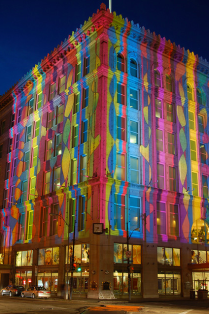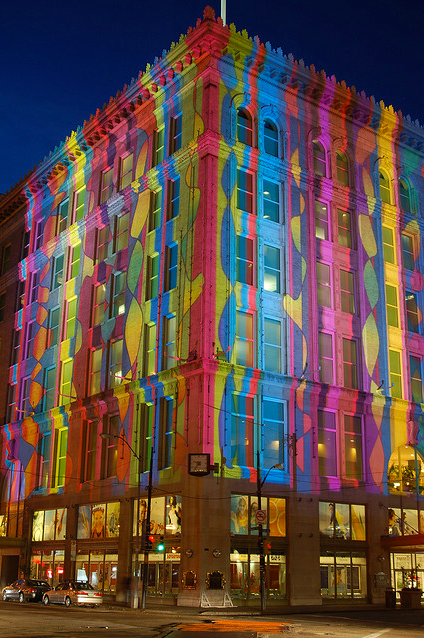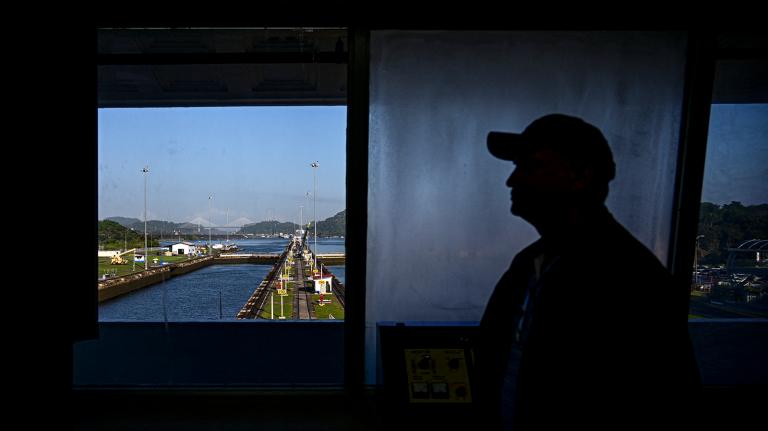
Old buildings get a fresh look during the Pittsburgh Festival of Lights. (Photo by Richard Dudley.)
Last month, I spent a glamorous, fun-filled, sawdust-flavored week in the city I know best as my hometown’s rival: Pittsburgh, enemy of Clevelanders everywhere. As an AmeriCorps member with Rebuilding Together — a national nonprofit that renovates and repairs owner-occupied homes for low-income homeowners — I was obligated to attend a workweek celebrating the legacy of Martin Luther King, Jr, and his commitment to service. I expected to end the week with great memories and a sense of accomplishment; I didn’t expect to fall in love with the city of Pittsburgh along the way.
Our work was in the Homewood neighborhood, separated from wealthy areas like Shadyside and Squirrel Hill by an elevated busway. Cut off from the rest of the city, the early-20th-century houses dotting Homewood’s genteel streets have blighted and declined in value as residents who could afford to leave moved out. Pittsburgh has shared the Rust Belt’s general population loss, and impoverished neighborhoods like Homewood have been hit especially hard.
Rebuilding Together Pittsburgh has been in the neighborhood for a couple years now and aims to be there for many more, assisted by both public and private partners — including the Pittsburgh Project, an innovative faith-based nonprofit dedicated to revitalizing the city (which also housed us out-of-towners for the occasion), and residents like Elwin Greene, the energetic and optimistic founder of Homewood Nation.
There was a lot of work to do: Of the 70 AmeriCorps members present, some painted, some sheetrocked, some hauled trash, and many did all of the above. I spent MLK Day in a dumpster and the rest of my time on stairs — building steps to a back porch and basement, and fixing an interior staircase whose ornately carved bannister served as a reminder of Homewood’s upper-class roots. Although the staircase was beautiful once, someone had fallen through it recently, and my goal was not to restore its beauty but its safety. (Which was easily done — six years of living in California may have left me laughably susceptible to snow and cold but it has also taught me to build things to survive earthquakes — those steps are never coming down!)
Alongside decay, however, are signs that Pittsburgh is thriving. My parents drove in for a night, and my defiant, committed Clevelander of a father was entranced by the city’s relative success. We meandered across snowy hillside roads, observing enough intact housing stock to make any of Pittsburgh’s Rust Belt brethren jealous, and as we dined at a hip downtown Latin-Asian fusion restaurant, my dad quizzed our bemused busser about exurban development and average commute times. (“Less than an hour?” she responded, backing away slowly.)
I posited that Pittsburgh might have been saved, in part, by its topography: Bland, big-box redevelopment is much more difficult without flatlands, and the hilly, river-intersected natural environment might serve to protect the urban, built one.
“It’s the San Francisco of the Midwest,” my father rhapsodized as we drove back to their bed & breakfast, a stately century-old Victorian in a once-rich neighborhood that housed a grand and colorful Art Noveau wonderland — and all so reasonably priced that even my frugal parents caved in to its charms.
“They don’t like to be called ‘Midwest’ here,” my mother replied.
Midwestern or not, Pittsburgh is a far cry from the San Francisco Bay area, where I now live — and that’s a good thing, because what Pittsburgh is instead is, well, Pittsburgh. Sure, its downtown might be stocked with some trendy (and tasty) restaurants, but nestled in its snowy hills among picturesque bridges are gems of both the architectural and human variety, as gorgeous old houses sell for less than 50k and imaginative intervention bubbles in home-brewed organizations like the Pittsburgh Project.
Rebuilding Together’s base for the week in Homewood was a makeshift warehouse inside of an old Rite-Aid, and I can’t think of a more perfect demonstration of Rust Belt resilience: leveraging decay and brand-name abandonment into reinvestment and grassroots-driven opportunity.
It happens in Pittsburgh, and throughout the Rust Belt, because residents have no other choice but to use whatever they’ve got, to apply creativity and persistence to limited resources and see just what they can do. As an outsider waging a similar uphill battle in my own underdog city of Oakland (I wrote about that here), I found both hope and truth in Pittsburgh’s fight to save itself: hope in how far they’ve come already, and truth in how much Pittsburgh deserves to be saved.
Yep, one week was enough to make me a convert. Homewood — and the city in general — may have been dismissed by many, but I’m rooting for it. Just don’t ask me to root for the Steelers. I may have learned to love my Rust Belt rival, but I’ll always be a Clevelander at heart.



